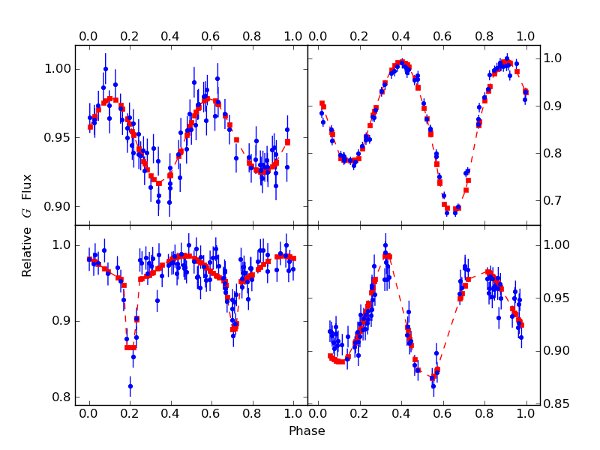|
In the course of its mission, Gaia is expected to obtain multicolour epoch photometry ("light curves") for at least several hundred thousand, and possibly up to several million, eclipsing binaries, most of them previously unknown. Spectroscopic data (radial velocity curves) are also expected to be available for a subset of these systems.
The Eclipsing Binaries Development Unit is responsible for processing the light and radial velocity curves of systems identified as eclipsing binaries upstream in the pipeline (mainly by CU7). The aim is to extract as much useful information about the physical parameters of these systems as allowed by the quality of the data, the requirement for an automatic processing, and infrastructure constraints (e.g., the availability of CPU resources). This task is accomplished by comparing the observables (photometry and spectroscopy) with model light curves of known physical parameters, and picking the model that "best" fits the observables in a maximum-likelihood (least squares) sense.
In general, finding the best model is not a trivial task because the least-squares function is not quadratic in the model parameters. For this reason, a two-step procedure is followed. First, the observations are compared to a database of precalculated models spanning a wide range in parameter space in order to find the model closest to the observations. The parameters of this model are then used as initial estimates for a least-squares optimization that homes in on the nearest minimum. This approach improves the chances of finding the globally best solution, rather than falling into a local minimum "trap".
The four figures shown here, provided by DU436FirstPublicLight (2010), illustrate some early results from this endeavour. The blue circles with associated error bars represent simulated observations of eclipsing binaries in the G band, generated by CU2. The fluxes are scaled so that the brightest datapoint in each curve correspond to a flux of one. The size of the error bars varies depending on the apparent G magnitude of each binary, with smaller error bars implying a brighter system. Phases are calculated from transit times assuming that the period of variability is known (as provided by CU2). Transit times were sampled according to the Gaia scanning law, resulting in between 68 and 89 transits. Finally, the red squares represent the flux predictions of the best-fit model for the same times. The dashed lines are straight-line segments that simply connect the red squares.
The quality of the fits is overall quite good. However, work is under way to improve on several aspects of the procedure. The current priorities are (i) to incorporate multicolour photometry and radial velocity information in the fitting procedure (currently only the G-band photometry is fit); (ii) to make a number of performance improvements, for example in the calculation of models with elliptical orbits which is time-consuming because of the need to recalculate the Roche geometry as the distance between the two stars varies; (iii) to optimize the parameter coverage of the model database; and (iv) to implement an intelligent way of dealing with errors in period determination, and in particular with period aliasing, which will become issues when the period is calculated from the data. Because the period will be an output of CU7 and, sometimes, of the Spectroscopic Binaries Development Unit as well, the Eclipsing Binaries Development Unit is in collaboration with these Units to ensure an efficient handling of the problem.
[Published: 27/10/2010]
|








































 Sign in
Sign in
 Science & Technology
Science & Technology

